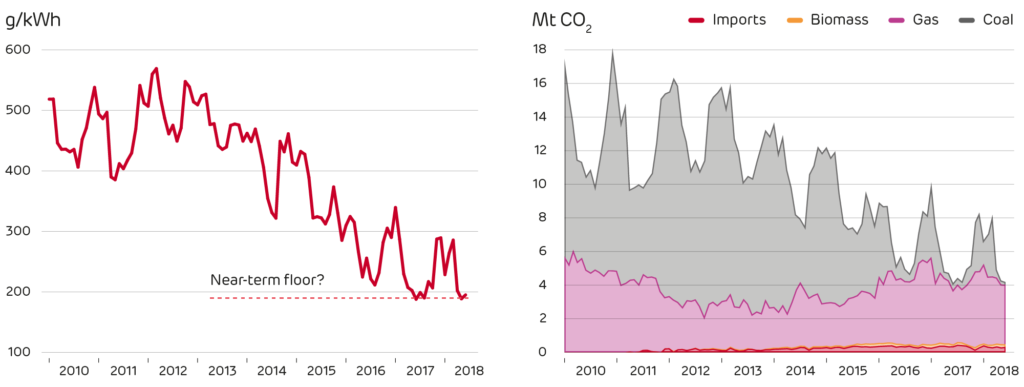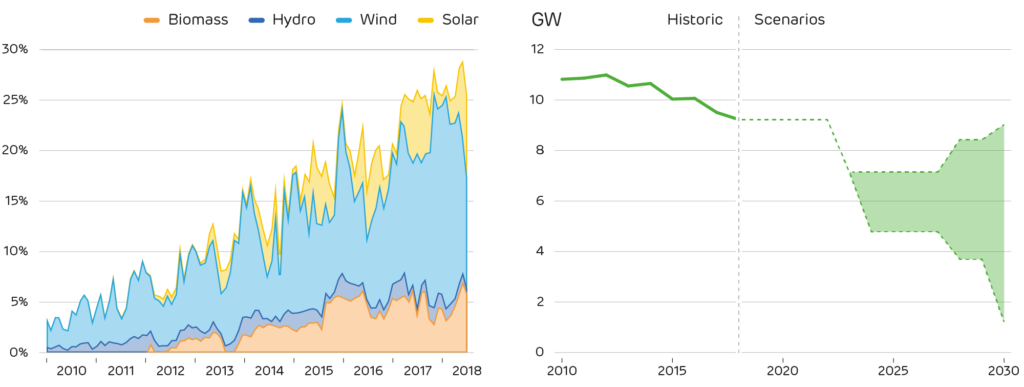Q2 2018: Has Britain’s power sector decarbonisation stalled?
Download PDF
by Dr Iain Staffell – Imperial College London
The UK has seen a remarkable reduction in carbon emissions from the power sector, but this rapid progress may be about to slow down.
For the last four years, emissions reductions have been in the range of 12–24% per year, thanks to gas replacing coal, and renewables (plus imports of French nuclear power) displacing fossil fuels. Such progress could never go on indefinitely, and three factors mean that future emissions reductions are likely to be tougher and much slower:
1. the easiest option of removing coal is almost at its end;
2. growth in renewables is a more gradual process and is facing uncertainty; and
3. Britain will lose nuclear capacity as old plants will have retired before new plants can be built.
The era of slow progress may already be upon us. The carbon intensity of electricity generation in Quarter 2 averaged 195 g/kWh – a new record for Britain, but only 2% lower than achieved in Quarter 2 of 2017 (see chart below below). The reason is that generation during the summer months has settled on a similar pattern: 25% nuclear, 25% renewables, 40% gas, 8% imports and 2% coal. Until these shares start shifting, the recent experience of 200 g/kWh in summer and 275 g/kWh in winter will not budge.
The monthly-average carbon intensity of electricity consumed in Britain (below left). Carbon emissions from generating electricity each month by source (below right)

Phasing out Britain’s coal consumption has been a major success story. Coal has gone from supplying 43% of Britain’s electricity in 2012 to 7% during 2017. This only fell slightly, to 6%, in the first half of 2018. Britain’s coal power stations have gone from annual emissions of 129 to just 19 million tonnes of CO2 over the last five years (see chart below). This has corresponded with a small increase in emissions from gas, but the main issue is simply that the bulk of the emissions savings from closing coal plants have already been made. Government expects to phase out the remaining coal by 2025, implying future savings at one-eighth of the current pace (19 Mt in eight years, versus 22 Mt per year over the last five years).
The growth of renewables has been the other big success. Output from renewables has increased five-fold since 2010, and now consistently supplies a quarter of Britain’s electricity (see chart below). However, while they have grown consistently, they have done so relatively slowly; increasing their share gradually by 3 percentage points per year.
The share of generation from renewable sources each month since 2010 (below left). National Grid’s scenarios for Britain’s future nuclear capacity1 (below right)

This growth has been fostered by policies that are either defunct or where future growth will be limited. Around 25 GW of renewables have a contract through the Renewables Obligation (RO), 10 GW with Contracts for Differences (CfDs), and 6 GW with microgeneration Feed-in Tariffs (FiTs). However, the RO is now closed to new entrants, it is not clear whether there will be further CfD auctions for the most mature technologies (onshore wind and solar), and the FiT for rooftop solar will close in April 2019. This leaves only the CfDs for less mature technologies (mainly offshore wind and onshore wind on remote Scottish islands), where the government will allocate up to £557m across multiple CfD auctions into the 2020s. It is perhaps less clear than ever how Britain’s renewable capacity will grow over the next 10 years.
Thirdly, it is also unlikely that new nuclear power stations will plug the gap in emission reductions. Britain’s nuclear fleet is growing old, and half are expected to close for safety reasons by 2025, before Hinkley Point C comes online. EDF, which operates all British nuclear plants, is seeking lifetime extensions for the existing plants, but it is widely expected that nuclear capacity will dip in the coming decade before recovering in the 2030s (see chart, above).
While falling emissions from UK power generation offer much to celebrate, it looks as if progress is set to slow down in the next few years as the coal phase out culminates, renewables growth slows and new nuclear cannot stem the impending stream of retirements. Uncertainty also hangs over the future of other emerging low-carbon technologies such as carbon capture and storage, tidal lagoons and small nuclear reactors.
Continued progress can be achieved, but will require renewed focus to translate the switch from coal to gas into a switch from gas to low-carbon sources. The key question is whether government is willing to continue intervening in the electricity market to maintain its world-leading status on carbon reductions and to provide investors with the long-term security they need to finance construction, whilst maintaining public support towards clean energy.
1: http://fes.nationalgrid.com
Authors: Dr Iain Staffell, Professor Richard Green, Dr Rob Gross and Professor Tim Green.